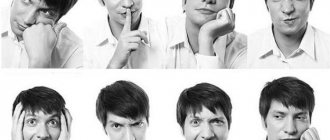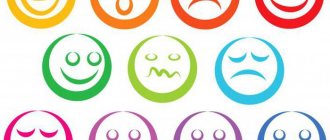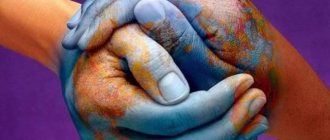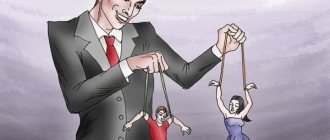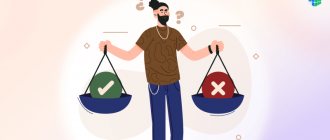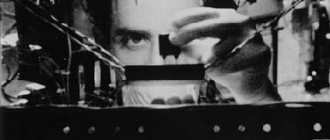I know how flies land on honey. I know death that prowls, destroying everything. I know books, truths and rumors. I know everything, but not myself. Francois Villon
Sometimes we can cross the line that seems impossible to cross. Sometimes we behave in such a way that we even judge ourselves for our wrongdoings. Why?
We cannot give explanations to many questions regarding our behavior. Do other people influence him, and how? What do we know about ourselves and our psychology? Are we independent in our narrowing? Who decided how to behave in society?
Behavior is the way a living being interacts with its environment that has developed during life.
Our behavior seems complex and inexplicable. It is believed that the essence of man is incomprehensible, and indeed this is so. No one knows how even a very close person might behave in a stressful or dangerous situation, since each of us has an instinct of self-preservation. And that's not the main thing. Human behavior depends on many factors.
Group behavior
This refers to the directed action of several people who are part of the same social group. Basically, the type of behavior of people is determined by the influence of certain processes directly related to the group itself.
The difference from other species is the consistency of the relationship between individuals, even if they are not in the same territory at the time of performing tasks.
Role of the group
Social norms, often the unspoken rules of a group, shape not only our behavior but also our relationships. An individual's behavior varies depending on the group of which he is a part, as well as the characteristics of the society that allow its norms to greatly influence society. Without social norms, human society will not function, as is evident in some countries today. People would have to be more abstract in their behavior as there would be no pre-tested "normal" standardized way of life and people would be able to make many more choices for their own personal good. However, the institutionalization of norms is inherent in human society. Perhaps as a direct result of the desire to be accepted by others, which causes people to manipulate their behavior in order to “fit in” with others. Depending on their nature, norms can impact different segments of society either positively (e.g., eating, dressing warmly in winter) or negatively (e.g., racism, drug use).
Sex role behavior
This division is a reflection of the behavior of people of a particular gender. It depends on the area, traditions, orders and other determining factors. It is expressed in the fulfillment of basic social roles established due to the life processes of specific social groups.
These types of human behavior are characteristic of groups of individuals. Their manifestations are directly related to the goals of society and the functions performed by members of society.
The influence of emotions
Personal behavior is greatly influenced by emotions. Let's take a situation where one person from a small company sees a predator, he gets scared and screams, to which the whole company will react the same way, while someone might not even see that predator.
If such a situation had occurred in a crowd of people, the scale of the consequences would have been more serious, and panic would have begun. For this behavior, there is no need for explanation in words; everything happens at the automatic level.
What is interesting about animal communication is the phenomenon that unites them into one group and keeps them there. Animals don’t speak, so they don’t have words in their heads like people do, but emotional information is programmed by nature in the form of their peculiar behavior.
The emotional family dependence of certain species of animals, thanks to evolution, has been transformed into a kind of social system. This suggests that animals live in one family and are kept in it due to the amount of emotions suitable for all members of the family, since the animals have nothing else to offer.
Competitive Behavior
This type of behavioral reaction of an individual is expressed in the fact that he perceives people as potential or actual competitors. This look provokes him to fight or compete with them. The main point of this behavior is to win or gain an advantage. It is directly related to the A type of human behavior in an organization.
These are impatient, irritable, distrustful, hostile people. Opposite to it is behavioral line B, according to which the individual does not strive for competition and treats everyone around him kindly.
Loading human culture
Under normal conditions, the loading of a person's culture or behavior begins from birth. The child, like all living things, is trying to save his life.
For him, the only possible threat is considered to be a negative assessment from his parents. The kid is trying to figure out how to avoid such a threat, or even better - to gain approval, he tries to adjust his behavior so as to avoid any threat.
Unfortunately, many adults believe that a child will grow out of only what was put into him from the moment of birth, without paying special attention to his upbringing. As a result, children are not in the best places to collect information, hence the inappropriate behavior of children.
People can tell jokes well and truly believe what is presented with emotion when the information appears genuine and serious. Our behavior is partly based on this. But it’s difficult for us to distinguish genuine emotions from high-quality acting.
If information comes as a priority in a certain activity, with appreciative emotions, then the person will begin to strive to obtain this priority. This is easy to understand using advertising as an example. We all trust the advertised product, buy it and hope that we will get the same result that the advertisers so sincerely talked about.
Other forms of social behavior
One of the special forms of social behavior is the desire for success. It directly affects not only the performance of a person, but also his entire life. In the last century, this type of behavior was clearly expressed in society. Avoiding failure is also an important behavioral manifestation.
It is expressed in a person’s desire not to be worse than those around him and to strive with all his might to reach their level or even become better. Some people strive to communicate with a large number of people, others, on the contrary, avoid society. There are manifestations of the desire for power, attempts to retain it, and the opposite type - humility. You can also highlight confidence and suspiciousness. The first type is manifested in belief in one’s strength and achievement of success. The second is expressed in defeat due to doubts and fears.
Biological context
Biology is very closely related to the issue described in this article. Social behavior is not something that is unique to humans. It arose as a result of long-term natural selection. Although there is some disagreement about how to precisely define behavior in a biological context, one general interpretation, based on a meta-analysis of the scientific literature, states that “behavior is the internally coordinated responses (actions or inactions) of entire living organisms (individuals or groups) to internal and/or external incentives.”
A broader definition of behavior, applicable to plants and other organisms, is similar to the concept of phenotypic plasticity. It describes it as a response to an event or environmental change during a person's life that is different from other physiological or biochemical changes and occurs more quickly. At the same time, it excludes changes that are the result of development (ontogenesis). Behavior may be innate or learned from the environment. The principle of a behavior is whether it is dependent on the environment or is externally learned. That is, it is influenced by both the environment and the environment of other creatures and the will of the subject himself.
What is behavior? It can be considered as any action of the organism that changes its relationship to the environment. It provides access beyond the body into the environment.
Creativity and Creativity
It is assumed that creativity is characteristic of every person to one degree or another. Creativity pushes people to step out of their comfort zone. For example, the invention of the first practical airplane by the Wright brothers. The aircraft first flew in 1903, and fifty years later the first passenger jet airliner was introduced. Creativity has helped people live in harsh conditions and has also made some of them rich. We also use creativity in our daily lives, such as when finding a destination.
Typology of psychotypes according to A.E. Lichko
Soviet psychiatrist A.E. Lichko, based on extensive research, identified the following personality types in psychology:
- Schizoid;
- Hyperthymic;
- Hysterical;
- Cycloid;
- Psychasthenic;
- Epileptoid;
- Sensitive;
- Conformal;
- Emotionally labile;
- Asthenoneurotic;
- Paranoid;
- Unstable;
Let us briefly describe personality psychotypes, external signs and behavioral characteristics.
1. The schizoid personality type gives a person duality. They tend to be withdrawn, experience difficulties in interpersonal communication, and are emotionally cold. They have an extravagant imagination. Alcohol is often used as a communication drug.
2. The hyperthymic type is characterized by mobility, restlessness, sociability, noisiness, high spirits, lack of perseverance, and mischief. The importance of their own personality is greatly overestimated, they are drawn to companies, sometimes asocial.
3. Hysterical types aspire to leadership positions
They differ in that they want to attract attention to themselves at any cost (egocentrism). They love praise very much
People of this type are prone to pretense, unnaturalness and posing. Feelings are superficial, willpower is weak and, as a rule, low authority.
4. Individuals with a cycloid psychotype are prone to mood swings. Activity and playfulness on the rise with a tendency to binge drinking can give way to a decline in mood up to subdepression. Such periods are characterized by weakness, lethargy, boredom, and a desire to be alone.
5. Psychasthenics are prone to “self-flagellation” and “self-criticism.” They are indecisive, suspicious, timid, experience obsessive fears, and are angular in their movements.
6. Representatives of the epileptoid type are characterized by the following traits: increased jealousy, angry malice, cruelty, and imperiousness. In a state of alcoholic intoxication, they are capable of aggression, often fall into unconsciousness, and exhibit sadomasochistic tendencies. At the same time, they have accuracy, pedantry and frugality.
7. Personalities of the synthetic type are very worried about their inferiority, are impressionable, and are prone to intellectual and aesthetic hobbies.
8. Conformists, like chameleons, easily adapt to environmental conditions. At the same time, they are weak-willed. In a good team, they make excellent performers. At the same time, they can drink themselves to death “for company” and cannot refuse. The self dissolves in the environment.
9. The emotionally labile type is characterized by extreme changes in mood even for insignificant reasons. Increased attachment to loved ones and relatives, very susceptible to signs of attention.
10. Asthenoneurotics are very capricious and irritable. As a rule, they sleep poorly, suffer from hypochondria and poor appetite.
11. The paranoid type is very distrustful, suspicious, and always on edge.
12. Individuals with an unstable psychotype are characterized by the following manifestations: lack of initiative, easy subordination. They often fall into bad company and are prone to gambling, idleness, pleasure and antisocial behavior.
Psychotypes according to Jung.
Jung divided personality types based on two general concepts: introversion or extroversion, as well as the main preferences of each personality type:
Condition 1. Where does a person get energy from?
An introvert is a person whose attention is directed inward; he receives energy from within. An extrovert's interest is directed outward; he receives energy from his environment. Condition 2
How a person accumulates knowledge. Methodically and scrupulously, based on facts, the sensory-sensing psychotype collects information. Intuitive people act mostly irrationally, based on the situation. Condition 3. How a person makes decisions. The thinking-logical type acts after an objective analysis of data. The emotional-feeling type makes decisions based on emotions, without unnecessary thinking. Condition 4. Concerns lifestyle. The rational type systematically implements the planned scenario. The perceiving type is often unpredictable, spontaneous, and flexible.
Based on the above conditions, Jung identified 8 psychotypes:
Application of the disc model
The main objective of the disc model is its application in business for establishing contacts and promotion. Working with competitors, partners and employees consists of interpersonal communication at different levels. To achieve greater efficiency, communication tricks are used. For example, “red” people are easily put off by unnecessary compliments, while “yellow” people accept them with pleasure.
The DISC personality type system is also used in personal communication. However, she is more focused on work. Adapting to a colleague, partner or boss means observing business etiquette and acting to achieve certain goals.
Establishing contacts in everyday life using knowledge of disc helps determine whether a further relationship with a particular person will develop. If you have to constantly adapt to a friend while he doesn’t do the same, what kind of friend is he then?
Studying the personality type recognition system develops communication skills and helps you better understand people. This knowledge will certainly be useful in life.
Raising the younger generation
One of the most important moments in raising the younger generation is conversations about behavior at school. The purpose of such conversations should be to expand the knowledge of schoolchildren about the culture of behavior, to explain to them the moral meaning of this concept, as well as to develop in them the skills of correct behavior in society. First of all, the teacher must explain to students what behavior is, that it is inextricably linked with the people around them, that how the teenager behaves determines how easy and pleasant it will be for these people to live next to him. Teachers should also cultivate positive character traits in children using the examples of books by various writers and poets. The following rules also need to be explained to students:
- how to behave at school;
- how to behave on the street;
- how to behave in a company;
- how to behave in city transport;
- how to behave when visiting.
It is important to pay special attention, especially in high school, to such an issue as a girl’s behavior in the company of classmates, as well as in the company of boys outside of school.
Antique typology
Even before Theophrastus, Hippocrates created the doctrine of the internal juices (or liquids) in the human body. This is: yellow bile (lat. cholos),
black bile (lat.
melas cholos),
blood (lat.
sanguis)
and mucus (lat.
phlegma)
. From the four main juices he derived four temperaments:
- Choleric (mood changes strongly and quickly, tense, mental states are directed primarily outward).
- Melancholic (the mood is strong, but changes slowly, tense, mental states are directed mainly inward).
- Sanguine (mood changes slightly and quickly, is not tense, mental states are directed primarily outward).
- Phlegmatic (mood changes slightly and slowly, is not tense, mental states are directed primarily inward).
What is the disc model
The disc system is a characteristic of personality types. William Marston identified 4 such types:
- Dominance - dominance;
- Influence (formerly Inducement) - influence (formerly motivation);
- Steadiness (formerly Submission) – constancy (formerly compliance);
- Compliance - compliance.
For clarity, each type was assigned a color:
- D – red;
- I – yellow;
- S – green;
- C – blue.
A person’s emotional state can be easily read by his facial expressions, manner of speaking, and communication. Having found out which category the interlocutor belongs to, you can build a convenient, profitable, productive model of interaction. This is especially true in business marketing, where it is important to establish contacts with managers, directors, and PR people.
The disc behavior model is also used by employers to determine the strengths of employees. Each type has a number of psychological differences that affect performance. Testing is carried out to determine the behavior model.
In everyday life, the DISC typology is not used so often, although the study of behavioral characteristics is never superfluous. Each personality is unique, but still has traits characteristic of one of the above types.
So, the disc system is a personality typology that allows you to determine the priority and strong areas of a person’s capabilities. Each type has characteristics, positive and negative character traits. The difference between them is so obvious that you will probably immediately identify your own behavior pattern.
Domination
Dominance - dominance. A “red” personality is a self-confident person who is able to control emotions. For the “reds” it is important to show themselves, to constantly demonstrate their own importance, to have control over what is happening, to dominate the weaker, to achieve goals at any cost.
| Positive traits | Negative qualities |
| efficient operation; | rude manner of communication; |
| persistence; | excitement; |
| lack of fear of difficult tasks; | hot temper; |
| lack of fear of difficult tasks; | low level of attention to detail; |
| high speed when making decisions, even important and serious ones; | stress provokes aggression; |
| constant activity; | impatience; |
| flexibility in difficult situations. | the desire to get what you want immediately, here and now. |
In business, “reds” become leaders and managers. They are capable of leading a team, but people follow them not of their own free will, but because of weakness and fear.
Influence
Influence - influence. “Yellow” individuals strive to gain recognition. For Type I people, it is important how they look and what others think of them. They are subject to outside influence. “Yellows” prefer to achieve goals beautifully, and at the same time they love it when they get the laurels of a winner.
| Positive traits | Negative qualities |
| optimism, faith in the best; | lack of punctuality; |
| developed communication skills; | sloppiness during work; |
| the ability to find a common language and win over; | stress provokes obsession; |
| love of novelty and creativity; | reluctance and inability to work with documents; |
| goodwill. | excessive impulsiveness. |
“Yellows” become leaders whom people follow of their own free will, openly and friendly. The lack of commitment affects the quality of work. Such bosses have a lazy team because the manager himself neglects the rules.
Constancy
Steadiness - constancy. “Green” individuals prefer stability, consistency, modesty, convenience and comfort for others. They do not stand out from the crowd, are punctual and predictable. For the “greens,” the most important thing is consistency: no changes are desirable, only conservatism.
| Positive traits | Negative qualities |
| reliability; | excessive compliance; |
| love of order in everything; | fear of everything new; |
| calmly performing boring, monotonous work; | high sensitivity and touchiness; |
| avoiding conflicts; | lack of desire and ability to refuse; |
| interlocutor and respond positively to his proposals. | secrecy, introversion. |
Greens rarely become leaders. They find it difficult to control someone. The best option is to obey someone and do the work systematically.
Correspondence
Compliance - compliance. “Blue” personalities are called scrupulous, precise, neat. Type C people prepare an action plan in advance and strictly follow it. Each point is a corresponding action. Unlike the “reds,” the “blues” achieve their goals not expressively, but systematically.
| Positive traits | Negative qualities |
| high organization; | condemnation; |
| the desire to destroy barriers; | excessive scrupulousness, intolerance to mistakes; |
| low degree of trust in others; | unwillingness to adapt and compromise; |
| accuracy; | stress causes withdrawal; |
| attention to detail; | reluctance to speak in public and avoidance of lengthy communication processes. |
| ability to analyze. |
The Blues can achieve success, but they will constantly face obstacles in the form of unreliable partners and constant mistakes from subordinates. Working alone brings more results, but takes up a lot of resources.
Socionic personality types
Socionics is a science designed to study personality types and the relationships between them. She pays a lot of attention to the perception and use of information that a person encounters every day.
There are the following types of personality:
- Dostoevsky. He is distinguished by highly developed intuition and the ability to empathize. At the same time, he will never put his interlocutor in an uncomfortable position. Innate politeness and sense of tact will not allow him to offend a person;
- Yesenin is able to calculate the outcome of an event in advance; he acts several steps ahead of the others;
- Don Quixote lives outside of boundaries and time. He finds several ways to solve problems and can evaluate the benefits of each action;
- Jack London. A person of this type is cold and acts based on logic. To achieve the goal, he notices everything that surrounds him, using information and people as resources;
- Stirlitz wonderfully organizes the work of the group, acting as its leader. Everyone will feel comfortable. Stirlitz himself is also capable of completing the tasks facing him;
- Hamlet lives by emotions, skillfully managing them to create the atmosphere he needs;
- Robespierre is conscientious, responsible and efficient. Power and glory are in last place for him;
- Balzac is able to notice details and will not forget to make a caustic remark, which is why he is often considered a cynic;
- Gaben loves comfort and regularity in everything. He will choose comfort and tranquility, protect himself from noise and bustle;
- Huxley is curious and attentive. He can read between the lines and see what others see as fantasy. He tends to dream, which helps him reach unprecedented heights;
- Gorky thinks rationally, putting cause-and-effect relationships at the forefront;
- Dreiser lives based on moral principles. If something goes against them, he falls into indignation and will never give up his opinion;
- Dumas is a true introvert who creates his own cozy world;
- Napoleon is a leader, a fighter, striving to show his superiority at every opportunity. He is stubborn and always gets his way;
- Zhukov is also confidently moving towards the goal. Guided by cunning, showing selfishness, regardless of people and their desires;
- Hugo is charismatic and positive. He charges everyone around with a positive attitude.
Napoleon as an image of a sociotype
Each of the personality types in psychology belongs to one of four groups:
- parents;
- infantile personalities;
- aggressors or victims;
- victims.
Note! According to psychologists, opposites form strong pairs; they attract and complement each other. For example, Jack London and Dreiser, as a victim and aggressor, or Don Quixote and Dumas, an infantile personality and a parent
